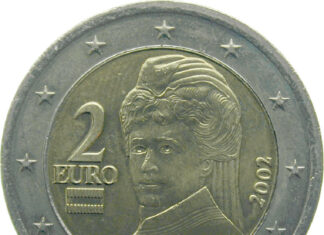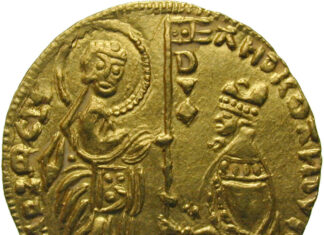Archives
Numismatic Puzzle: Bertha von Suttner
In 1905, Bertha von Suttner became the first woman to receive the Nobel Peace Prize. The Nobel Committee thus honoured the life’s work of this dedicated pacifist and writer. Today, her face can be found in many purses and wallets: on Austria’s 2-euro circulation coins.
Numismatic Puzzle: Leonhard von Keutschach
In 1500, the Archbishop of Salzburg Leonhard von Keutschach had this silver batzen minted. Through his reforms he turned Salzburg into one of the richest principalities of the Holy Roman Empire.
Numismatic Puzzle: Melanesian Boar’s Tusk
This is a boar’s tusk. On a group of islands east of Australia, wealth is traditionally quantified using pigs as a unit of measurement. Circular boar’s tusks are still used as bride price or atonement money – and they even adorn the national flag of Vanuatu.
Numismatic Puzzle: Scheepjesgulden
These “ship guldens” were minted by the Dutch in West Friesland for their colony at the Cape of Good Hope. When the Dutch lost this territory, they sent the coins to Batavia on the island of Java. There, they were finally put into circulation in 1803.
Numismatic Puzzle: Niccolò Tron
The doge was the highest official of Venice – and lost more and more of his power as time went on. In the 1470s, Niccolò Tron became the only doge to be portraited on a coin, the Lira Tron, which was named after him.
Numismatic Puzzle: Gian Galeazzo Maria Sforza
This gold double ducat from c.1475 depicts Gian Galeazzo Maria Sforza. In name – and in name only – the youth was Duke of Milan as he was under constant guardianship until his early death. What remains are coins minted for him depicting splendid Renaissance portraits.
Numismatic Puzzle: The Noble
In 1340, England’s King Edward III defeated France in a sea battle – the beginning of the Hundred Years’ War. He celebrated this victory in 1344 with a new gold coin, the noble. For centuries, the noble was an extremely popular coin on the continent, too.
Numismatic Puzzle: The Doge of Venice
Today’s coin is of the type of a Venetian ducat, a so-called zecchino. This gold specimen from around 1350 shows the doge, the head of state of Venice, receiving a banner by St Mark, the city’s patron saint.
Numismatic Puzzle: Schaffhausen
In the 11th century, Kloster Allerheiligen (All Saints Abbey) in Schaffhausen was granted the right to mint coins. Take a look at this 13th-century bracteate and decide for yourself what you see: a ram, as an allusion to the town’s name, or a Lamb of God?
Numismatic Puzzle: Matapan
Matapan is the Arabic term for the enthroned Christ on the reverse of a heavy Venetian silver coin introduced around 1200. Today, however, you will put together the obverses’ motif: St Mark who presents the banner to the head of state.












